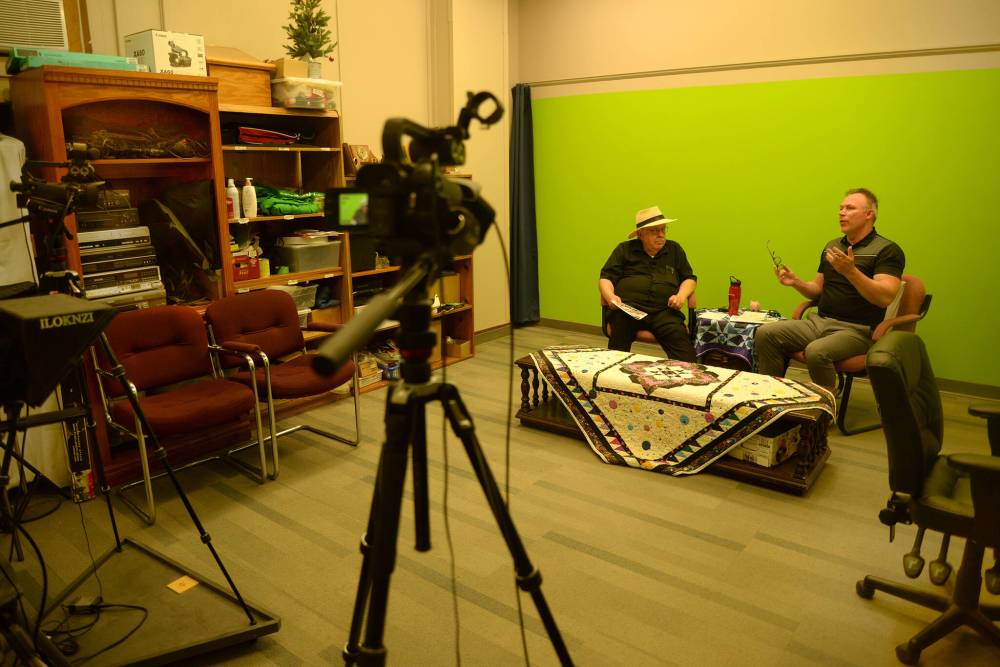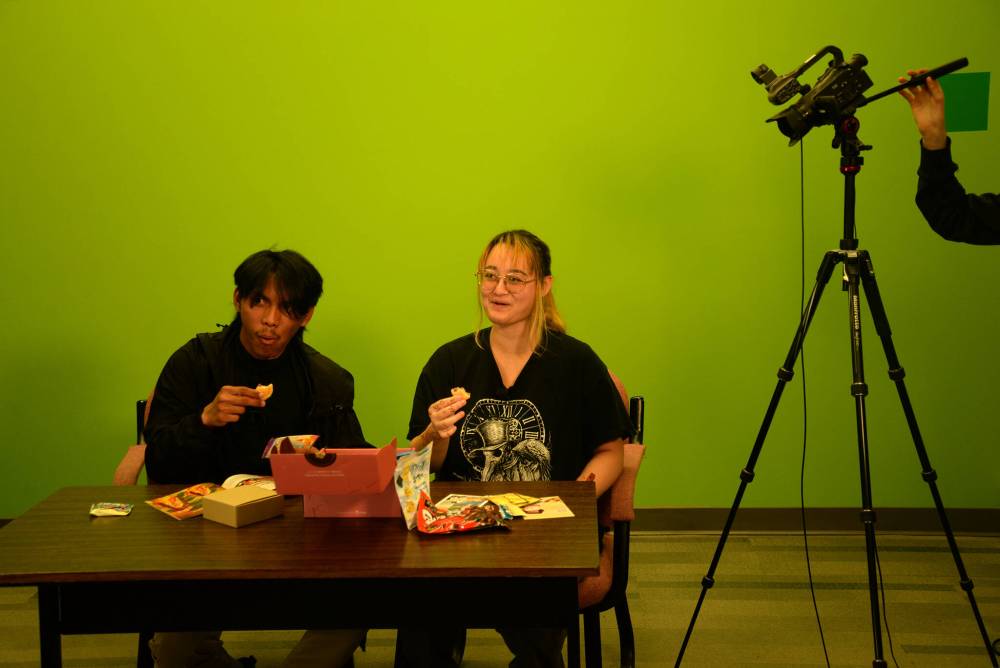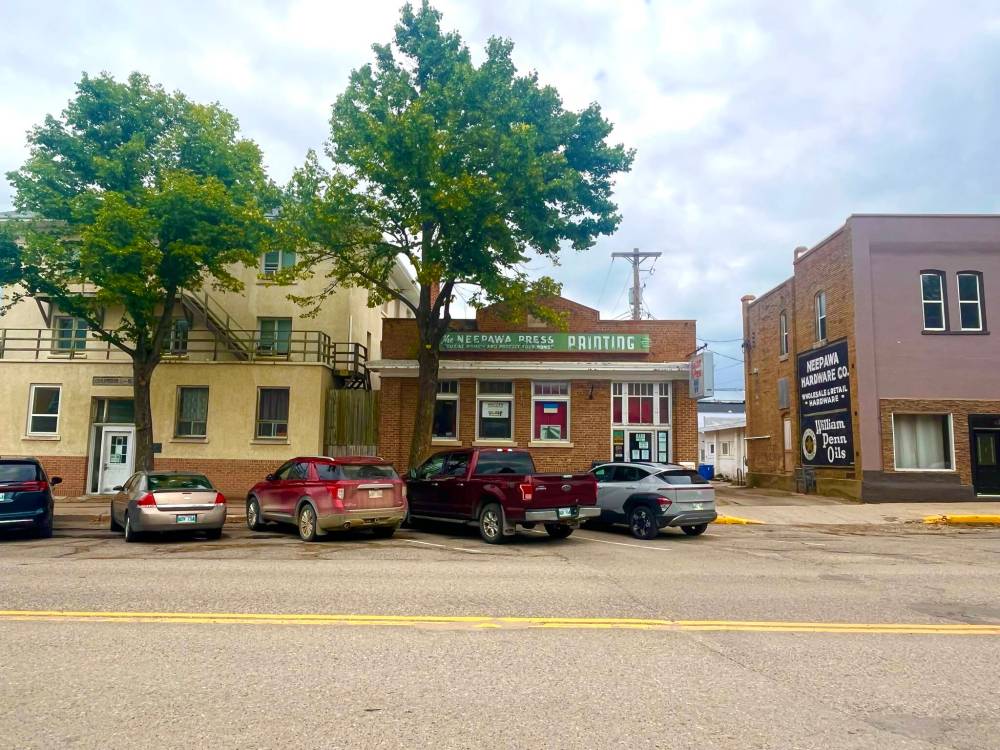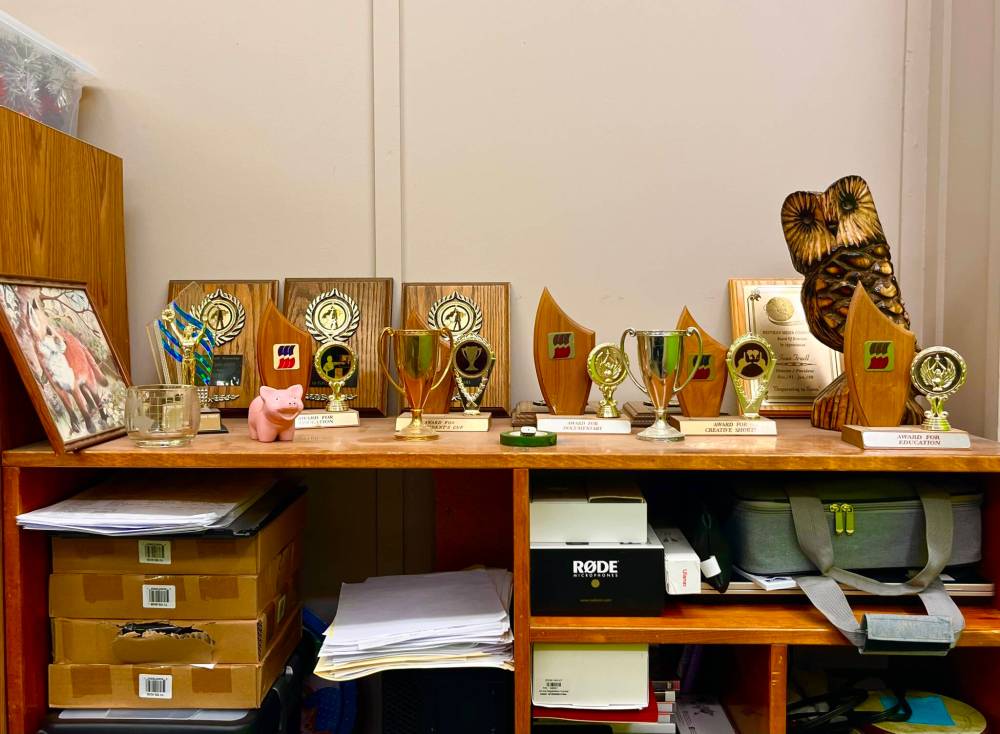Politesse over provocation Neepawa’s public-access TV channel offers rare respite from air rage in an era of political polarization
Read this article for free:
or
Already have an account? Log in here »
To continue reading, please subscribe:
Monthly Digital Subscription
$0 for the first 4 weeks*
- Enjoy unlimited reading on winnipegfreepress.com
- Read the E-Edition, our digital replica newspaper
- Access News Break, our award-winning app
- Play interactive puzzles
*No charge for 4 weeks then price increases to the regular rate of $19.00 plus GST every four weeks. Offer available to new and qualified returning subscribers only. Cancel any time.
Monthly Digital Subscription
$4.75/week*
- Enjoy unlimited reading on winnipegfreepress.com
- Read the E-Edition, our digital replica newspaper
- Access News Break, our award-winning app
- Play interactive puzzles
*Billed as $19 plus GST every four weeks. Cancel any time.
To continue reading, please subscribe:
Add Free Press access to your Brandon Sun subscription for only an additional
$1 for the first 4 weeks*
*Your next subscription payment will increase by $1.00 and you will be charged $16.99 plus GST for four weeks. After four weeks, your payment will increase to $23.99 plus GST every four weeks.
Read unlimited articles for free today:
or
Already have an account? Log in here »
Neepawa’s first ever LGBTTQ+ Pride celebrations in 2024 were cause enough for local controversy.
But even coverage in the Neepawa Banner & Press and the community’s public-access station NAC-TV rankled social conservatives in the fast-growing rural town of about 5,500.
“I had people really mad at me for it… I said, ‘If there was a public hanging in the middle of the square we’d probably put that in the news too,” says former Neepawa mayor Ken Waddell who, with his wife Christine, publishes and owns myWestman.ca and the Neepawa Banner & Press.

CHERYL HNATIUK / FREE PRESS
Ken Waddell, manager of Neepawa’s Community Access Television Station (NAC-TV)
Waddell — who also writes a column in the Banner called Right in the Centre, with a disclaimer that newspaper staff does not necessarily share his views — says by interview that he has “very little sympathy with the whole rainbow thing.”
But, as an editor, he thinks that’s beside the point.
“I’m right-wing, but we take a fair approach all the time. You never should shut down an opinion, least not right away, because you never know what’s a good idea,” he says.
“I’m right-wing, but we take a fair approach all the time. You never should shut down an opinion, at least not right away, because you never know what’s a good idea.”
Rrain Prior, who works for Waddell, will also tell you she believes passionately in representing a balance of diverse political voices. But she certainly doesn’t share his views on Pride. In fact, she’s on the town’s Pride committee.
Since 2021, she’s been the general manager and production manager of NAC-TV, where Waddell is the acting manager. But if you ask him, he’ll be the first to say she runs the show at the station — describing his role at NAC-TV as more nominal than anything.
And Prior can’t help but sometimes have an opinion about content at the Banner — which is one desk over at 432 Mountain Ave. in Neepawa, where the TV station and newspaper share office space.
“There was a fundraiser for the Pride flag…. And someone had, in a very disingenuous way, written a letter (to the Banner) about that to say, ‘Why not raise the Filipino flag instead?’” she says.
“Well, we’re also doing that. They both went up.”
The Neepawa Banner ran the letter by local resident Bryce Parrott, which described the Filipinos as an integral part Neepawa’s “life and culture” and the Pride flag as a “controversial” political symbol that represents a “harmful” ideology. A heated debate ensued in the town’s media and, one imagines, gathering spaces.
“The next week, there were about seven letters in response to it — not just from the queer community here but the Filipino community saying, ‘Don’t use us to prop up your views,’” she says. The Banner ran some of these responses, too.
Meanwhile, NAC-TV has consistently run Pride-related coverage that can hardly be mistaken as neutral in these debates — interviews with organizers, “coffee chats” with drag queens, stories on Pride-themed trail hikes.

CHERYL HNATIUK / FREE PRESS
Rrain Prior, who formerly worked as a writer for the online edition of the Toronto Star, is the news director at Neepawa’s Community Access Television Station (NAC-TV).
As a self-identified “lefty,” Prior — a tattooed media veteran who worked at the Toronto Star before returning home to Neepawa — knows she often swims against Neepawa’s political currents.
But flip through NAC-TV’s programming, and you’ll still glimpse the gamut of local perspectives and personalities she helps to represent — from citizen round-table events and Rotary Club presentations to city council meetings and interviews with political candidates across the electoral spectrum.
“We’re not just showing ourselves as a community. We’re allowing the community to show itself to the world.”
At a time when Canadian media feels increasingly dominated by social media influencers and Toronto-based media giants, both Prior and Waddell see independent western Canadian media — not least small-town newspapers and TV stations — as providing a vital counterbalance.
Although their editorial approaches differ, both Prior and Waddell clearly value giving a platform to Western Canadian voices from across the ideological spectrum.
“We’re not just showing ourselves as a community. We’re allowing the community to show itself to the world,” says Prior. “We can help make (western Canadian) voices heard, right?”
Neepawa provides the setting for one of Canada’s most celebrated novels, Margaret Laurence’s The Stone Angel.
In the town — or its fictional counterpart, Manawaka — the community’s Protestant work ethic and conservative social code make for a deeply claustrophobic environment for her novel’s characters and those of other works of historical fiction Laurence set there.
While Neepawa clearly still has its moments of friction around traditional norms, in other ways today it seems strikingly unlike Laurence’s universe.
It’s one of Canada’s fastest-growing communities — 13th fastest according to Statistics Canada’s 2021 census data. Much of this owes to recent influxes of Filipino residents, thanks largely to demand for workers at the town’s HyLife Pork Processing plant.
Neepawa is also home to one of Canada’s only remaining public-access television stations. Prior estimates that there are fewer than 30 left in Canada.

CHERYL HNATIUK / FREE PRESS
Neepawa’s Community Access Television Station (NACTV) NACTV Manager Ken Waddell, left, and Eoin Devereux, journalist, in discussion on their show that discusses news and issues from the Neepawa Banner and Press.
Launching in 1983, during public-access TV’s heyday, NAC-TV has a small studio and control room in which a tight-knit team of staff, volunteers and summer students dart back and forth.
Part civic forum, part variety show, its programming blends local political news with charming homegrown fare — scavenger hunts, Filipino heritage events, high school sports and graduation ceremonies.
None of it seems to get quite as gonzo as the Pollock & Pollock Gossip Show, an inspired Winnipeg public-access cult classic which saw Natalie (“Nifty”) Pollock bouncing around Shaw’s studio with her equally wacky sibling host Ron (“Rockin’”) Pollock for five glorious years in the 1980s.
But with its green-screen magic and volunteer camera operators, NAC-TV still has some of the charming DIY trappings of old-school public access, when Canadian cable providers were more strictly required to set aside a single channel for community use.
“There’s this idea of community television that it still looks like Wayne’s World,” says Prior. “But (NAC-TV) is also central for civic engagement… and media literacy is really one of the pillars of community TV.”
NAC-TV’s CRTC licence means it can broadcast across Canada, and it’s carried by Westman cable and Bell MTS. Prior hopes they’ll be carried by Shaw soon, too.
Meta’s censoring of Canadian news content on Instagram and Facebook in a blunt response to the federal government’s Online News Act affects domestic media big and small, and Prior is grateful NAC-TV is still able to post its programming to YouTube to help meet audiences where they are.
But she sees a crucial line between social media and traditional media’s priorities — even in the grassroots world of community TV, which still requires the oversight of fact-minded editors.
“Everyone should have a voice, but not every voice is a news source,” she says. “There’s no barriers to putting your stuff out (online)… (but) we lack media literacy now to know a good source.”
“We’re a little frustrated with the noses-in-the-phone thing all the time,” seconds Waddell. “If we tell a lie on NAC-TV, we’re going to be called out about it by nine o’clock the next morning.”
For Waddell, it’s not just a matter of traditional versus social media. It’s about how a connected local community still plays a vital role in keeping its journalists in touch with public needs.

CHERYL HNATIUK / FREE PRESS
Marbert Tagbacaola (left) and NAC-TV intern Keira Mendoza McKay film a public-access show for which a box of surprise treats from Japan are sampled and then described to viewers.
“We want to talk about things that are important to us. You know, if this hog plant were to close here, we’d be pretty damned interested,” he says. “I’ve often said that the best decisions are made by those closest to those who are affected.”
For Prior, this “two-way street” relationship between media and its audience is strongest when media is local.
“In the one direction, we bring information in to our local audience about the issues that matter to them and are held accountable for the veracity of that information,” she says. “In the other direction, the media outlet brings information about the community or the local area to a wider audience.”
All of this leaves quite a lot of room for creativity at NAC-TV, much of it from young people.
Keira Mendoza McKay, a 21-year-old NAC-TV intern, grew up in Alberta and the Philippines and is heading into her second year of media and communications studies at Assiniboine College in Brandon.
While she seems most interested in becoming an artist, she says she’s throwing herself into her reporter role, spending much of her time interviewing local businesses and public figures.
“I think it’s quite nice and peaceful here. There’s a lot it has to offer,” she says.
“You don’t need a bot to tell you your own thoughts… you should be able to think for yourself.”
The siren song of AI (or “AI slop” as McKay calls it), Parrott’s locally infamous letter of which she’s critical, the relationship between southern Manitoba’s Filipino and LGBTTQ+ communities — all of these are topics of lively conversation in McKay’s segments.
McKay has also created a ‘plein-air’ painting session — reminiscent of Bob Ross, the gently spoken American painter famous for his calming step-by-step landscape tutorials on PBS — and an unboxing video.
These feel like clear nods to online culture, where Ross-inspired ASMR and unboxing videos are a hit. Yet at a time when few things sting more online than being branded a “boomer” — anyone seen as out of step with social media’s trends — she takes some more mature stances.

CHERYL HNATIUK / FREE PRESS
NAC-TV’s Rrain Prior can’t help but express her opinions about content decisions by Banner & Press publisher-owner Ken Waddell as the two media outfits share office space in downtown Neepawa.
“People my age see news online — or not news, but fake info… And I get really annoyed, because I work at a news station. I’m not reading stuff off Tik Tok… like ‘Oh, I’m gonna believe this without even fact-checking,’” she says.
“You don’t need a bot to tell you your own thoughts — you should be able to think for yourself.”
While she’s not sure she wants to become a journalist herself — a hard sell these days, apparently — she sounds like familiar voices in this newspaper and so many others: troubled by the ways social media and AI are undermining the educational roles of news media and schools.
Prior thinks a lot about the future of news media.
She was a presenter at the Manitoba government’s recent all-party committee on the survival of journalism, where she focused on the economics of local news.
When it comes to government support, she believes it’s pretty simple: buy more ads.
“There’s no conflict of interest, there’s no nebulous funding stream… you’re buying ads that have nothing to do with what we’re doing. It doesn’t feel like a subsidy,” she says.
Waddell’s position on government support of local journalism is similar.
“They should be telling us what they’re doing,” he says. “They should put an ad in the paper to say, ‘We’re planning to build this many miles of road’ and paying for the press release. Because, really, we’re giving them free messages.”
Prior also believes stakeholders of small-town media may not always neatly fit the federal funders’ diversity, equity and inclusion (DEI) criteria, as their small size often limits diversity simply due to the very small number of staff positions.
“There are closed definitions of diversity that you have to meet,” Prior says. “Meanwhile, you’re maybe in a very diverse community — or one where (their definition) doesn’t apply.”

CHERYL HNATIUK / FREE PRESS
Neepawa’s Community Access Television Station (NAC-TV) has won numerous awards for its work.
While much has been said about the fragility of print and traditional media in our screen-saturated, media-consolidated world — the crack-ups are often most serious in marginal milieus that fail to capture notice in much of the DEI discourse: small towns.
The Canadian Centre for Policy Alternatives recently reported that over the past 15 years, one in 10 news outlets in towns of under 30,000 has closed — across all provinces except Ontario.
“All voices need to be heard when it comes to a healthy democracy.”
For Prior, the creep of news deserts in Western and rural Canada isn’t just about loss of representation in the media sense, but also in the political sense.
“When a local media outlet is lost, that audience loses not only a critical source of information, but it also loses its own voice in a wider arena,” says Prior.
“All voices need to be heard when it comes to a healthy democracy, not just for decision-makers but for everyone to see lives that are lived outside of their experience and understand the diversity of this province and this country.”
conrad.sweatman@freepress.mb.ca

Conrad Sweatman is an arts reporter and feature writer. Before joining the Free Press full-time in 2024, he worked in the U.K. and Canadian cultural sectors, freelanced for outlets including The Walrus, VICE and Prairie Fire. Read more about Conrad.
Our newsroom depends on a growing audience of readers to power our journalism. If you are not a paid reader, please consider becoming a subscriber.
Our newsroom depends on its audience of readers to power our journalism. Thank you for your support.





